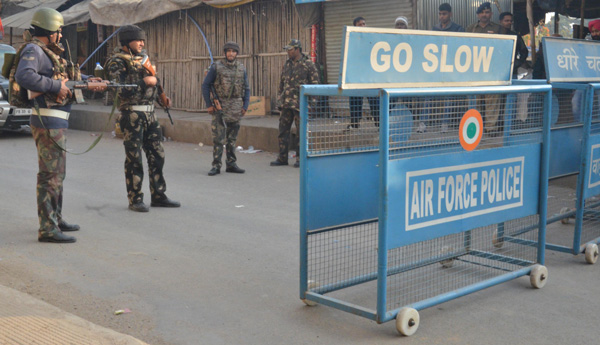Question time: could #PathankotAttack have been avoided?

Gurdaspur's superintendent of police, Satwinder Singh has proven to be an interesting piece in the Pathankot attack puzzle. His car was stolen by unknown men in the wee hours of Saturday morning. His cell phone was also snatched by the same lot.
The SP's inputs
Satwinder suspected that they were terrorists. But when he went to report the stolen items and his suspicion about the men being cross-border infiltrators, "no one took him seriously."
Also read - #PathankotAttack: The framework for talks has to change drastically: G Parthasarthy
A retired director general of military operations asks, "An SP of a sensitive district of Gurdaspur, where the terrorists had struck just 6 months ago was out without his security detail."
Now apparently he is being questioned by the National Investigation Agency (NIA). The general asserts: "If I were the National Security Adviser, I would have taken him in for rigorous questioning right at the beginning."
Clearly, he holds some key information that could have accelerated the operations at the Pathankot air force base. And the operation would not have resulted in the country being converted into a spectacle of ineptitude for all to laugh at. We could even have saved the lives of 7 servicemen. Even after almost 55 hours from the beginning of the action on the ground, the security forces weren't clear how many men there actually were.
For, Singh had reported four. Now that the operation has ended for the second time - first was on Sunday when the Union Home Minister Rajnath Singh had tweeted the end of the encounter little too early, though he later deleted it.
Intelligence break turns into a debacle

Soldiers take position near the air force base on 3 January. Photo: Sameer Sehgal/Hindustan Times/Getty Images
There is now speculation that there could have been two groups that came together. If that was the case, then this action that was being touted as a major intelligence break, can turn into a colossal failure.
They were identified as Jaish-e-Mohammad (JeM) terrorists almost immediately after the first shots were fired, because of some "written material" left in the first car they had tried to steal. They subsequently killed the driver. However on 4 January, United Jihad Council (UJC) claimed responsibility for the attack. The UJC is led by Hizbul Mujahideen chief Syed Salahuddin.
Also read - #PathankotAttack: Modi has 3 choices. He needs to pick one and stick to it
Coming back to the attack, apparently intelligence agencies listened to 4 phone calls that the terrorists made. The Indian Express even quoted the times at which the calls were made and successfully intercepted.
If indeed the JeM is behind the attack, it seems to have either fallen into bad times or is being under-supported by the Inter Services Intelligence (ISI). For, these fidayeens did not carry satellite phones, something that has been provided in most terrorists attacks seen so far. Instead, they used the mobile phones stolen from the SP and his companions.
What high alert?
But the pandemonium doesn't end there. The point of entry into a key air base is supposed to have been on high alert. Even in normal circumstances it is supposed to be heavily guarded. SO how did these terrorists enter the grounds of the air force base? All that is known so far is that they had abandoned poor Satwinder Singh's car about 500 yards away from the main gates.
The forces guarding the gate were of the Defence Security Corps (DSC) - older in age, often retired army jawans, and lightly armed. This was despite that 'intelligence breakthrough' and the 'high alert.' Was there even a command and control set-up at the air base? Ideally that should be the case in all circumstances, but definitely after the 'heads-up'.
The retired high ranking official of the army questions even the force structure being used at base. He says this is largely an infantry operation that could have been backed-up by army's Special Forces. He points out that the NSG's Special Operations Group that must have been doing the tasks, are ill-equipped for this kind of open arena warfare. Their tactical training is fighting in highly built-up areas and hostage rescue etc.
Today's news TV said that the lead force in the operation was the NSG, and Union home ministry was the nodal agency. Why? This is an air force installation and some army units are also stationed there. So shouldn't the defence minister have stepped up? But then Manohar Parrikar caught a commercial flight on Saturday and arrived at his South Block office at about 2 pm, long after the battle had started. Such was the 'high alert.' One really feels for the brave-hearts who take the bullets on their behalf and ours.
More in Catch - #PathankotAttack: 5 terrorists killed, 7 jawans martyred, still an ongoing operation
Meet the Afghan governor who has taken up arms to protect the Indian consulate in Mazar-i-Sharif
Pathankot Attack: Thumbs-up for Modi. There's no 'scrap the talks' chorus now





![BJP's Kapil Mishra recreates Shankar Mahadevan’s ‘Breathless’ song to highlight Delhi pollution [WATCH] BJP's Kapil Mishra recreates Shankar Mahadevan’s ‘Breathless’ song to highlight Delhi pollution [WATCH]](https://images.catchnews.com/upload/2022/11/03/kapil-mishra_240884_300x172.png)

![Anupam Kher shares pictures of his toned body on 67th birthday [MUST SEE] Anupam Kher shares pictures of his toned body on 67th birthday [MUST SEE]](https://images.catchnews.com/upload/2022/03/07/Anupam_kher_231145_300x172.jpg)






